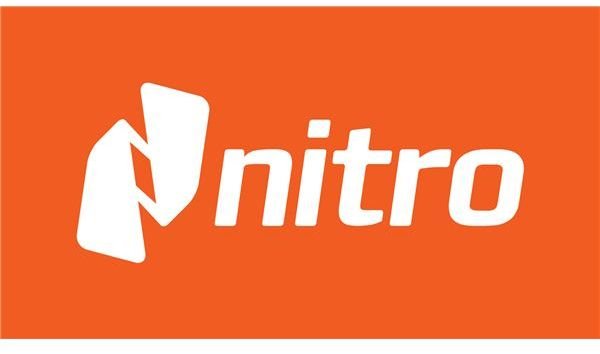Review of New Nitro Professional PDF 7: Good Tool for Creating PDFs?
What It Can Do
Nitro Professional PDF 7 is an application covering a comprehensive set of PDF needs. It provides the tools to create and edit full featured PDFs from some 300 different types of files. You can customize them with OCG layers, links, notes, editable forms, redact content, and provide both protection and digital signatures for security. Almost every aspect of the PDF you create is customizable.
How well does it work? I tried out a review copy of the new release.
What’s New for Version 7
Version 7 of Nitro Professional PDF has some new features, and I’ve been testing them out. In particular, the program lets you redact content in an existing PDF, create OCG layers, and do fairly extensive text editing in a PDF without need to go to a word processor or other Office type program. The PDF is virtually as malleable as a text editor, allowing you to edit and customize its features – and then sign it digitally or stamp it with custom stamps with the information you need at the time. Nitro also takes advantage of the ribbon in MS Office programs, integrated with an extra tab in the program ribbon, which allows you much more control of PDF construction than is usually available when saving as a PDF in Microsoft Office.
As well as adding new features, Nitro has improved existing ones. Rendering is sharper, text editing is easier, and they report they fixed over 1000 bugs in the previous release.
Ease of Use (4 out of 5)
Nitro Pro PDF was very easy to install as a download from the Nitro site. Setup asks you if you want to enable PDF viewing with Nitro in your
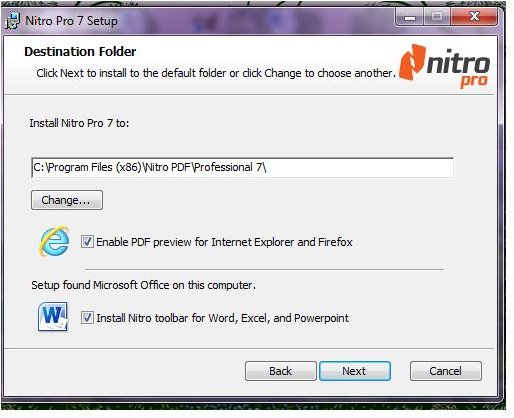
browser (IE and Firefox) and if you want to install the toolbar for Word, Excel and PowerPoint – which is what gives you the tab on your ribbon. System requirements are a Windows computer running XP, Vista or Windows 7, or Windows server 2003, 2008, for both x86 and x64 versions.
The program should look very familiar to Office users, as the ribbon at the top is a familiar blue, with tabs. The features are logically laid out, although I looked on the Edit tab when I tried to use the redact capabilities, and it turned out to be on the Protect tab. There is also a help section included and a downloadable PDF user guide – 240+ pages of information and instructions for using the different features of the software.
It was easy to convert a PDF file into a Word document for extensive text editing, although you could edit text right on the PDF page as well.
Nitro offers you the ability to combine different elements into a single PDF; a useful feature, but not particularly polished. It is an area where Corel Fusion has it beat hands down. Nitro lets you pull different files into a list and order them, but you really cannot edit the whole before creating the PDF, and there is no provision for putting materials together in different scale or using part of a document before creation, let alone the visual editor found in Corel Fusion.
A minor frustration was not being able to find the list of 300 file types which can be converted by Nitro into PDF files. I was surprised that it was not included in the User Manual.
Creating a PDF from a file is easy - merely drag the file onto the Nitro Pro desktop icon. You can pull a file directly from Windows Explorer, or put a file on your desktop and drag it. It gives you the option to open it in Nitro Pro immediately, or just save it.
An important note on the 300 file types: you must have an installed application which can open the file before Nitro Pro will create a PDF from the file. This means you cannot just import any file sent to you or downloaded. I’m not completely sure why, as Nitro Pro has the ability to do the conversions built in.
Features and Performance (4 out of 5)
Nitro has a long list of included features, some of which will be quite handy in an Enterprise context. While I did not try any multi-user projects, PDFs can be worked on by multiple authors, digitally stamped to indicate who and when and securely encrypted after digital certification or signing. It also offers users the ability to add Bates numbers.
PDFs made with Nitro adhere to the standard ISO format, which allows them to be read by anyone with PDF readers made by other companies, as well as giving Nitro the ability to edit other PDFs opened in the application. You choose whether to make a PDF, a flattened PDF or a PDF/A.
Editing inside a PDF is possible – on a paragraph level. Within a paragraph – each a separate object – text can be inserted or deleted, and the entire
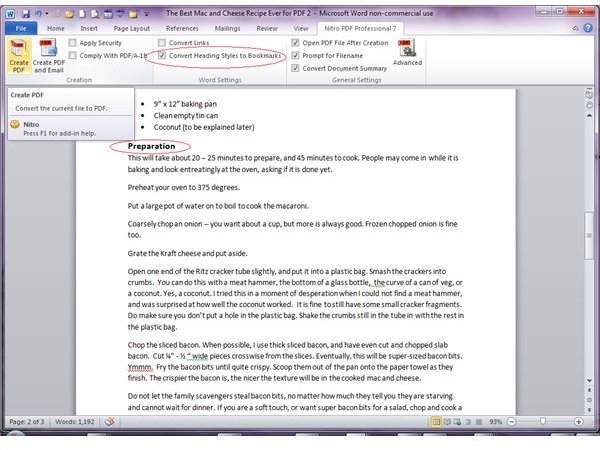
paragraph will re-flow. Because paragraphs are separate objects, the re-flowed lines can make the paragraph longer and alter the spacing inside the PDF, as the new line can overlap an existing paragraph that is not being edited, depending on the spacing.
For extensive editing, or adjustments involving insertions, converting the PDF back to Word, Excel or PowerPoint is recommended. This also means that using the delete function inside a paragraph you are editing leaves a blank area on that page.
Exporting back and forth to MS Word was clean – no changes in the text or font. I did notice that the document, which had been imported into Nitro PDF with the box Convert Headings to Bookmarks option checked did indeed open in the PDF with bookmarks for the headings. However, converting it into a MS Word doc, editing some normal text, and converting it to a PDF file again lost the style on the headings, so they reconverted as bold normal text.
There is a setting in the Nitro Pro preferences for conversion, which when checked is supposed to detect headers and footers and make sure they keep that style in the new doc, but it does not reimport bookmarks in the PDF as headings. You’ll need to reapply the heading style to have bookmarks in the reconverted version.
A similar problem occurs when converting and re-converting Excel files. The original conversion made bookmarks from sheet names in a workbook, giving each sheet a page in the PDF. Converting that back to a workbook did make each page a sheet, but the sheet titles reverted to Sheet 1, etc., rather than taking the bookmark name for the sheet name.
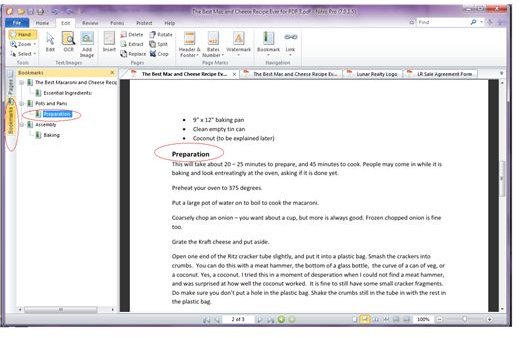
Ordinarily text or other additions added to a PDF or any edits are kept on an annotation level, not the content level. You can open the edit tab, and insert material on a page on the content level by using the flatten selection, flatten all or save as a flattened PDF options.
New features such as OCG support allow the user to modify content in layers, and print only the layers that are active. While you cannot create OCG content in Nitro Pro, importing layered content adds versatility.
Creating a digital signature was easy, and the signature background is transparent, so only the signature appears in the PDF and any underlying text can be read. Your signature can be protected by a password when you create it.
You can create custom dynamic digital time stamps for use in Nitro, and save the format for future use. As well, you can pull in timestamps from an external server if necessary.
Other security options include digital ID, certificates and the ability to redact content in the PDF. Redaction is useful for quick removal of sensitive

information before showing the PDF to others, and allows redaction both through search for words, and manual selection of blocks of text or images. All marked for reaction text is highlighted for review, and Nitro prompts you to make sure you want to permanently remove the content.
If
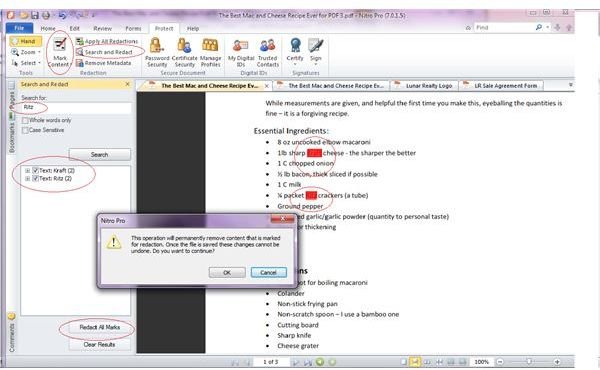
you redact and then decide that it was an error, you can also undo the redaction until the PDF is saved. When you do save the redacted PDF, Nitro asks what you want to rename the file, and inserts redacted after the title of the PDF as the default name, so you do not inadvertently copy over your original. As well, you can remove meta data from the PDF. This removes all information for author, organization, and so on.
Price to Value (4 out of 5)
Nitro Pro is advertised on the company website for $99.99, and upgrades are $49.99. There’s a free 14 day trial, and Enterprise pricing.
This compares to Corel Fusion at $69.99, and Acrobat X Standard at $299 (upgrade $139), neither of which has all of the features in Nitro Professional PDF 7. Acrobat X Pro is a closer product in features, but sells for $449 (upgrade $199). Corel Fusion makes creation of PDFs from multiple sources much easier than Nitro, but fails to provide many features included in this program.
Nitro Professional PDF 7 has some areas that could use improvement, especially in multiple source PDF creation, but it is a useful application with some unusual options, offering the ability to redact, timestamp, QuickSign with digital signature, format OCG layers and convert many different file types to PDF format as well as basic PDF editing functions. This version came out on November 2, 2011, so there hasn’t been time to fix any bugs at the time of this review. I think it is a good value for the price.
References
-
Screenshots by author.
-
Home site http://www.nitropdf.com/
